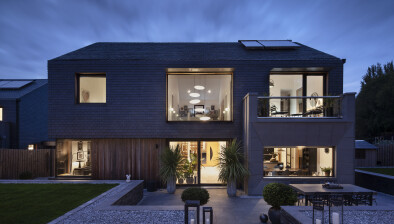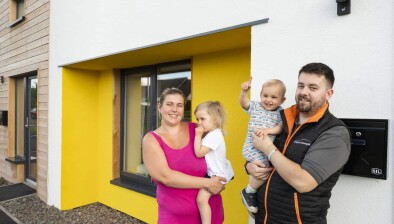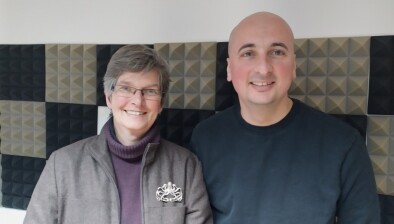Kate de Selincourt: Healthy homes - what Passivhaus offers Scotland
Kate de Selincourt
With the consultation on the Scottish equivalent to the Passivhaus standard expected to begin shortly, Kate de Selincourt from the UK Passivhaus Trust shares what it could deliver in terms of health.
Scotland has big problems with public health. The life expectancy at birth is the lowest in the UK, and health inequalities are among the widest in Western Europe. Many factors contribute to this, but public health experts make clear that poor housing has a significant role. Fuel poverty, cold, damp, noise and pollution are all consequences of poor housing, and all these shortcomings affect people’s health and life expectancy.
Cold and damp are probably the biggest threats to health, and they tend to appear together. A home that is cold and/or inadequately insulated, will have cold surfaces that attract damp. Occupants who are cold won’t open windows or vents if they can avoid it.
People in Scotland are extremely vulnerable to fuel poverty. The jump in energy prices in April 2022 saw a doubling of extreme fuel poverty to 1/4 of the population. The situation has not improved - and more than 30 Scottish households a week are self-disconnecting from their energy supply because they can’t top up their prepayment meters.
As just two examples, high blood pressure, a major contributor to the top killers, heart disease and stroke, is worsened by living in an underheated home. Asthma, the commonest medical condition in Scottish children, is worsened - and sometimes even caused - by living in a cold, damp or mouldy home.
BRE has estimated that the damage caused by unhealthy homes costs English society the equivalent of £11bn each year. Given the cool, wet climate and wide health inequalities in Scotland, the proportionate costs in Scotland will be every bit as high.
These issues are increasingly well understood. Yet our newly built homes are failing Scottish people. Research has shown that faults in design and construction mean new homes often cost far more to heat than predicted. Research commissioned by the UK government found that new homes can be noisy, under-ventilated, and affected by pollution from outside.
These multiple performance gaps represent a massive missed opportunity for public health.
It is genuinely exciting then, that in the face of these issues, Scotland is now reaching for a future where new homes enhance, rather than damage, people’s health.
When Scotland held a Climate Assembly of ordinary citizens, 97% voted in favour of Passivhaus or a Scottish equivalent construction standard. This was translated into proposals that won the support of 90% of public respondents, as well as parties across the Scottish Parliament; the new standard is due to be laid into legislation in December this year.
The Scottish Government will shortly release a detailed consultation on the proposed new construction standard for Scotland. If this new standard retains all the ingredients of Passivhaus, the new homes will have the potential to transform lives.
Passivhaus is rightly known for creating buildings that are supremely efficient in energy use. As well as its importance in the global quest for net zero, this efficiency makes an invaluable shield against fuel poverty.
But Passivhaus delivers much more besides. Careful design and equally careful quality assured construction lead to buildings that are quiet, comfortable and well ventilated. They have a very low risk of damp and mould.
Research into recently completed Passivhaus social homes in Scotland is already showing that Passivhaus delivers for Scottish residents.
The new tenants in the Passivhaus retrofit of a historic Glasgow tenement have seen fuel poverty disappear. The residents in the flats in Niddrie Road “report satisfaction with all the aspects of the home, particularly the low energy bills.” Several have said they didn’t have to pay for electricity at all during the worst of the 2022-23 price shock - it was fully covered by the Government rebate.
Indoor air quality and ventilation is as important to health as affordable warmth. Passivhaus buildings are fitted with constant whole-house ventilation that unobtrusively supplies pre-warmed air to every living space, while equally quietly removing damp air from kitchens and bathrooms. Monitoring of new Scottish Passivhaus homes has shown just how well this works.
Landlord Loreburn Housing Association assessed the mould risk in their new Passivhaus homes, compared with a group of equivalent homes built to SHQS Silver Standard. The Passivhaus homes scored far better. In the only non-Passivhaus home to achieve good ventilation, the occupants regularly opened the windows – something that not everyone is willing to or able to do. Monitoring of air quality in another Passivhaus development, at Closeburn in Galloway, backed up this finding.“Indoor air quality was very good throughout the monitoring period”
One of the tenants in the Glasgow retrofit commented: “I wish all the homes were like this one”.
It is wonderful to think that soon, because of the Scottish Government’s proposed new legislation, potentially all our new homes could be.
- Kate de Selincourt is a writer on sustainable construction, building performance and occupant health, and a researcher on ‘health, well-being and people performance’ for the UK Passivhaus Trust.








